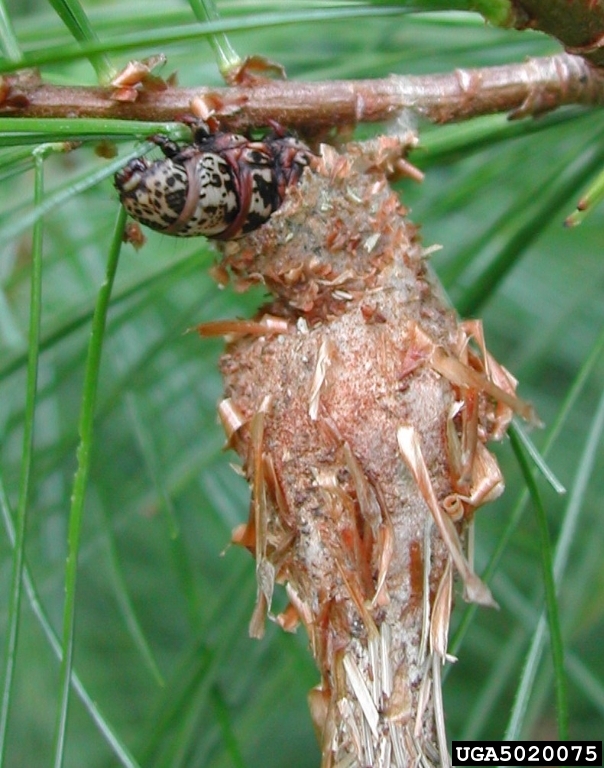Bagworms in the Landscape
go.ncsu.edu/readext?709457
en Español / em Português
El inglés es el idioma de control de esta página. En la medida en que haya algún conflicto entre la traducción al inglés y la traducción, el inglés prevalece.
Al hacer clic en el enlace de traducción se activa un servicio de traducción gratuito para convertir la página al español. Al igual que con cualquier traducción por Internet, la conversión no es sensible al contexto y puede que no traduzca el texto en su significado original. NC State Extension no garantiza la exactitud del texto traducido. Por favor, tenga en cuenta que algunas aplicaciones y/o servicios pueden no funcionar como se espera cuando se traducen.
Português
Inglês é o idioma de controle desta página. Na medida que haja algum conflito entre o texto original em Inglês e a tradução, o Inglês prevalece.
Ao clicar no link de tradução, um serviço gratuito de tradução será ativado para converter a página para o Português. Como em qualquer tradução pela internet, a conversão não é sensivel ao contexto e pode não ocorrer a tradução para o significado orginal. O serviço de Extensão da Carolina do Norte (NC State Extension) não garante a exatidão do texto traduzido. Por favor, observe que algumas funções ou serviços podem não funcionar como esperado após a tradução.
English
English is the controlling language of this page. To the extent there is any conflict between the English text and the translation, English controls.
Clicking on the translation link activates a free translation service to convert the page to Spanish. As with any Internet translation, the conversion is not context-sensitive and may not translate the text to its original meaning. NC State Extension does not guarantee the accuracy of the translated text. Please note that some applications and/or services may not function as expected when translated.
Collapse ▲Bagworms, Thyridopteryx ephemeraeformis, are a very common pest of Leyland cypress, juniper, arborvitae and cedar throughout the eastern United States. These pests have been hatching over the past month in our area, but may have gone unnoticed. Homeowners may first notice the damage that these insects cause as evergreen trees and shrubs begin to turn brown. Close examination of these plants will reveal the tiny, green, Christmas tree shaped bags that the caterpillars grow inside, hanging from branches. As bagworms feed on nearby foliage, these bags will grow with the insect. You might also find larger brown bags remaining from last year.
Bagworms overwinter as eggs within these bags, with the larvae emerging from the bag during May and June, depending on location and temperature. The larvae crawl or drift via silk strands to nearby foliage where they begin to feed. Bagworms are relatively sedentary, but are mobile within the canopy. The larvae feed on foliage during the summer as they grow and mature. When fully grown, the larvae permanently suspend their bags from twigs and change into pupa. Adult females are wingless and do not fly nor leave the tree. Male bagworms develop into a small brown moth which flies to bags to mate with females.
Bagworms feed on plant foliage and heavy infestations can defoliate trees and shrubs. Young caterpillars produce a silk bag on their posterior end that gradually collects plant material. This creates a bag covered in leaves or plant debris that camouflage larvae from predators. Since they do not move much as larvae they can build up dense populations. This can lead to excessive spread of these insects within the landscape, especially within a hedgerow of trees of the same variety.
Management of these insects can be difficult and time consuming since they are protected inside the bag. One of the most effective, yet time consuming methods of treatment, is hand-picking or cutting bags off of branches. This treatment is best timed in fall, winter, or early spring before the eggs hatch. When this is impractical or impossible, there are chemical control options available that should be applied when caterpillars are young. Now is the time to scout your evergreen trees as worms may still be small. Several products are available to homeowners for control such as acephate, spinosad, and bifenthrin. Bacillus thuringiensis (BT) may also provide satisfactory control, but typically only to smaller insects. Foliage should be thoroughly wetted with the insecticide spray in order to achieve thorough coverage. Bagworms will come into contact or consume the insecticide during their feeding. Insecticide will not provide control of eggs, and systemic products available for sucking insects like aphids or scale will not provide control. Bagworms are also susceptible to predation from parasitoids and birds that may assist in their control.
If you have additional questions about bagworms or their control, please contact Daniel Simpson at 252-745-4121 or daniel_simpson@ncsu.edu.





